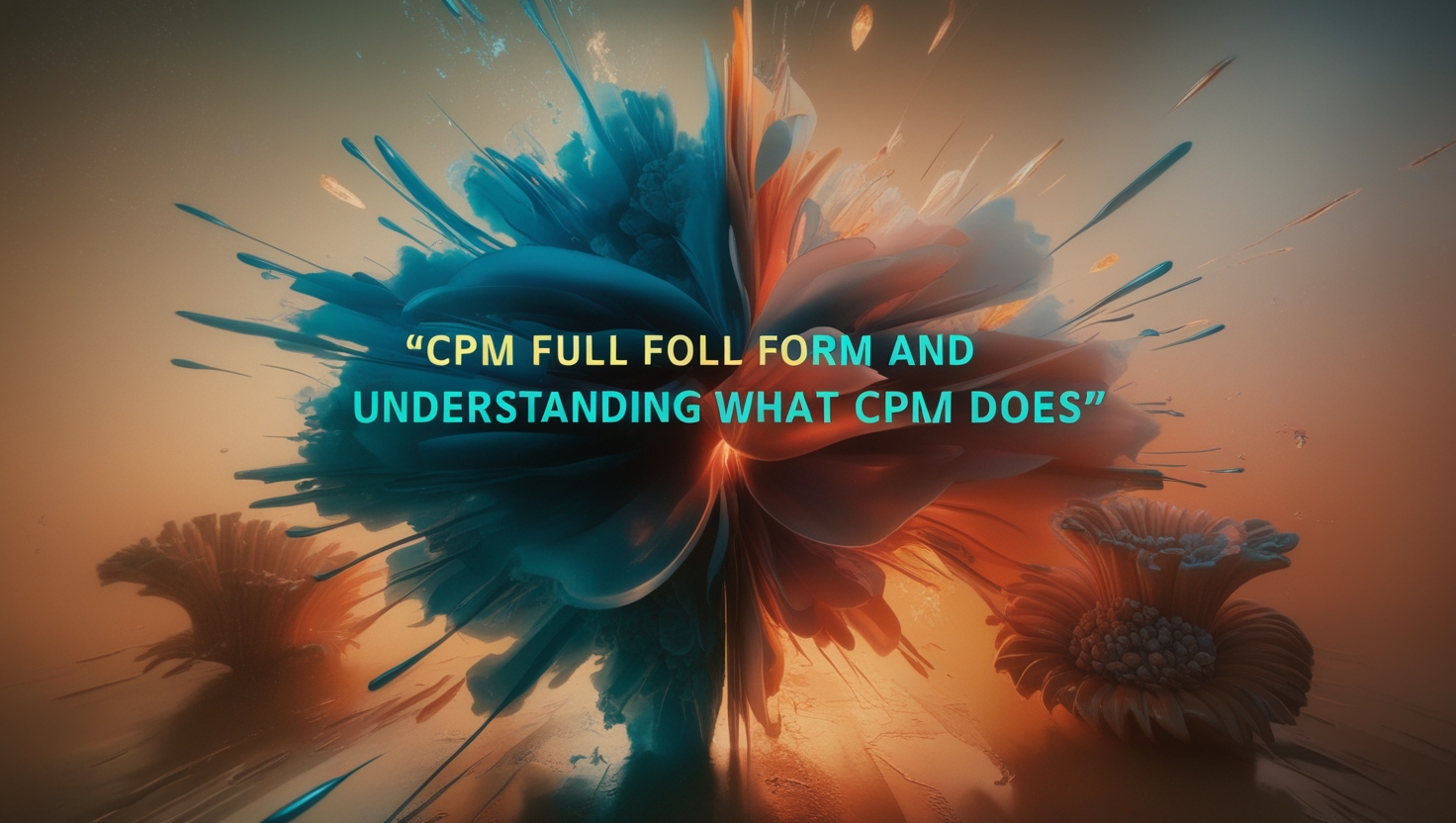By Saad, Published on 19-sep-2024.
A Comprehensive Guide to Understanding CPM in Advertising
CPM Full Form ?? The digital world is booming, and with it comes the evolution of advertising strategies, many of which are steeped in technical jargon that can be confusing to newcomers. One of the most widely used terms in online advertising is CPM, which stands for Cost Per Mile—or more accurately, Cost Per Thousand Impressions, where “mille” is derived from the Latin word meaning “thousand.” Whether you’re a business owner, marketer, or simply someone interested in understanding the dynamics of online advertising, this article aims to unpack CPM in an engaging and straightforward way.
What is CPM?
In the simplest terms, CPM refers to the cost an advertiser pays for 1,000 impressions of their advertisement. An impression means the ad has been displayed on a website or app—whether or not someone clicks on it. For example, if a webpage has a CPM rate of $5, the advertiser would need to pay $5 for every 1,000 times their ad is shown.
The formula for calculating CPM is straightforward:
CPM = (Cost ÷ Number of Impressions) × 1,000
This pricing model is one of the most common in digital advertising, particularly for display ads (such as banner ads) on websites and social media platforms. It provides advertisers with a predictable and scalable way to reach large audiences.
Understanding How CPM Works
I’ll explain it with a straightforward example from real life:.
Imagine you own a small business that sells handmade candles. You want to promote your products through an online banner ad. You’ve been offered a CPM rate of $10 by a website, which means you will pay $10 every time your ad receives 1,000 impressions.
If your ad gets 50,000 impressions in total, the cost calculation would look like this:
Cost = (50,000 ÷ 1,000) × $10 = $500
Thus, you would pay $500 for your ad to be shown 50,000 times to visitors on that site.
It’s important to note that CPM doesn’t guarantee any action from the audience. Whether or not people click on the ad, you still pay for the number of times the ad is displayed.
CPM vs. Other Advertising Models
CPM isn’t the only pricing model in the digital advertising space. Here’s how it compares to two other common models:
- CPC (Cost Per Click): In this model, advertisers only pay when someone clicks on the ad. The focus here is on getting people to interact with the advertisement. CPC is often used when the goal is to drive traffic to a specific webpage or generate leads.
- CPA (Cost Per Acquisition): CPA charges advertisers only when a specific action (like a purchase or form submission) is completed. This is performance-based pricing and is ideal for campaigns focused on conversions.
While CPC and CPA focus more on engagement and results, CPM is primarily about visibility. It’s often used for brand awareness campaigns where the objective is to get as many eyes on the ad as possible.
CPM and Click-Through Rate (CTR)
While CPM deals with impressions, there is another critical metric that helps advertisers assess the effectiveness of a campaign: CTR, or Click-Through Rate.
CTR measures the percentage of people who see your ad (impressions) and then click on it. The formula is:
CTR = (Clicks ÷ Impressions) × 100
For example, if your ad received 100 clicks out of 5,000 impressions, your CTR would be:
CTR = (100 ÷ 5,000) × 100 = 2%
While a high CTR is generally a good sign that your ad is engaging, it’s essential to understand that CPM campaigns are not always judged purely by CTR. For branding purposes, even ads that aren’t clicked can leave an impression on potential customers. This is particularly important for businesses aiming to increase brand awareness rather than drive immediate sales or website visits.
Why is CPM So Popular?
There are several reasons why CPM has become one of the most popular ad pricing models in the digital world:
- Visibility and Reach: CPM is ideal for brands that want to get in front of as many people as possible. Advertisers can plan their budgets based on predictable rates for impressions, and publishers can easily monetize their traffic.
- Scalability: CPM is straightforward to scale. Whether you’re targeting a niche audience or a mass market, CPM gives you a clear idea of how much you need to spend to reach your desired number of impressions.
- Awareness Campaigns: If your goal is to raise awareness rather than generate clicks or conversions, CPM is a perfect fit. It ensures your brand is seen by a broad audience, helping build familiarity over time.
- Ease of Use: CPM allows advertisers to set clear budget limits and goals based on visibility, which is simpler to track compared to performance-based models like CPA, where conversion data might be harder to obtain.
CPM in the Context of Digital Platforms
Different digital platforms may implement CPM slightly differently, and prices can vary based on factors such as ad placement, audience demographics, and website traffic.
For instance:
- On Google Ads, CPM campaigns are typically used in the Display Network, where banner ads are shown across various partner sites.
- On Facebook, advertisers can select CPM as their pricing model for both feed ads and Stories ads.
- YouTube offers a similar model called CPV (Cost Per View), which charges advertisers based on the number of times their video ad is viewed.
The cost of CPM can vary greatly depending on factors such as the platform, audience targeting, and competition. For example, Facebook’s average CPM might range from $5 to $10, while YouTube’s CPM could be significantly higher for in-stream video ads due to their engaging nature.
Factors Affecting CPM Rates
The CPM rate you’re charged depends on several variables, including:
- Target Audience: If you’re targeting a highly competitive demographic, such as millennials interested in technology, the CPM rate will likely be higher. Conversely, less competitive niches may offer lower rates.
- Geography: Advertisers often pay higher CPM rates in countries with more affluent populations, like the United States or Germany.
- Ad Placement: Prime real estate, such as ads at the top of a webpage or within a social media feed, often comes with higher CPM rates compared to less visible spots.
- Seasonality: Advertisers tend to spend more during peak shopping seasons, such as Black Friday or Christmas, which can drive up CPM rates as more businesses compete for visibility.
The Pros and Cons of CPM
Pros:
- Predictable Costs: CPM allows you to forecast how many impressions you can afford within your budget, making it easier to control costs.
- Ideal for Branding: If your campaign focuses on increasing awareness or visibility rather than direct engagement, CPM is an efficient option.
- Wide Reach: You can expose your brand to a broad audience, ensuring that it is seen by many people, even if they don’t click.
Cons:
- No Guaranteed Engagement: CPM charges you regardless of whether people interact with your ad. This can lead to wasted budget if the impressions don’t result in any clicks or actions.
- Potential for Low ROI: Since CPM doesn’t prioritize clicks or conversions, it may not be the best choice for advertisers focused on driving immediate sales or leads.
- Viewability Issues: Some impressions may not even be seen by users, such as when an ad is loaded at the bottom of a webpage that the user never scrolls to.
Real-World Example of CPM in Action
Let’s use another real-world example to make this more relatable. Imagine you run a local bakery, and you’ve decided to promote your new seasonal cupcakes through online advertising. You purchase a display ad on a popular food blog with a CPM rate of $12.
You decide to spend $600 on the campaign. The blog promises you will receive 50,000 impressions.
Here’s how it works out:
Cost per 1,000 impressions: $12
Total Impressions: 50,000
Cost: (50,000 ÷ 1,000) × $12 = $600
At the end of the campaign, your ad is shown to 50,000 visitors on the food blog. Even if a relatively small percentage of people clicked the ad, your bakery is now more widely known, and some users may have made a mental note to visit or check your website later.
Conclusion
CPM is a powerful advertising model, especially for businesses looking to increase brand awareness and gain exposure. While it doesn’t guarantee direct engagement, it ensures your ad is seen by as many people as possible. For advertisers who are strategic about their audience targeting and messaging, CPM can offer great value, particularly when combined with other metrics like CTR to measure overall campaign effectiveness.
In a digital landscape brimming with choices, understanding CPM is a crucial step toward making informed decisions about your marketing strategy. Whether you’re looking to reach new audiences, build your brand, or drive conversions, CPM provides a straightforward, scalable method for getting your message out there.
If you Liked Reading our Blog Read More Blogs Here and Below is the Link to our WhatsApp channel Join it for the Latest Post Updates. (Read For WhatsApp Channel Privacy and Security Here).
UseFull Resources:
| Resources | Resources |
|---|---|
| Tooldar: Tooldar | Hemingway Editor: Hemingway Editor |
| Ilovepdf3: Ilovepdf3 | Grammarly: Grammarly |
| Adorepdf: Adorepdf | Coursera: Coursera |
| Custom Design Agency: Articon Design Agency | Udemy: Udemy |
| Google: Google | Khan Academy: Khan Academy |
| Yandex: Yandex | Wolfram Alpha: Wolfram Alpha |
| Baidu: Baidu | TED Talks: TED Talks |
| Medium: Medium | Skillshare: Skillshare |
| Quora: Quora | Canva: Canva |
| Duolingo: Duolingo | Figma: Figma |
| Nerdfitness: Nerdfitness | Trello: Trello |
| DeepL: DeepL | Notion: Notion |
| LinkedIn: LinkedIn | Asana: Asana |
| Stack Overflow: Stack Overflow | Mailchimp: Mailchimp |
| GitHub: GitHub | Zapier: Zapier |
Note : These Above Resources Are just for Educational and ease of use Purposes we neither Endorse them, they were working at the time of sharing.
.Disclaimer: The information presented in this blog is for educational and informational purposes only and should not be considered financial, Political, or cultural advice. All efforts have been made to ensure the accuracy of the content at the time of writing.
Think We Missed Something?
If you notice an error or have a suggestion, we encourage you to submit a correction. Help us keep our information up-to-date and reliable!











